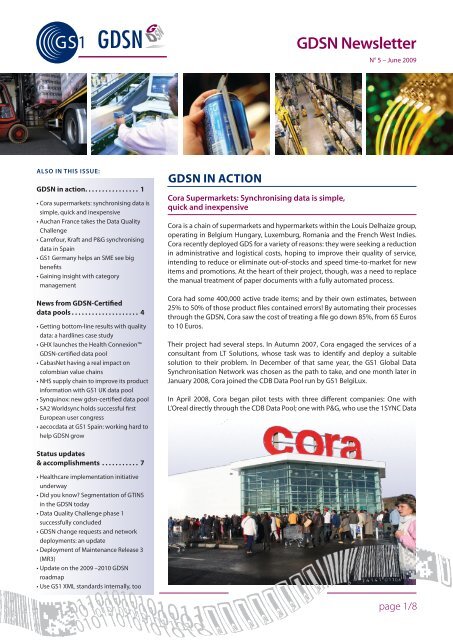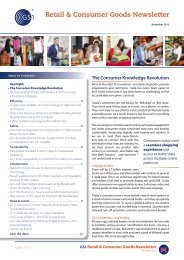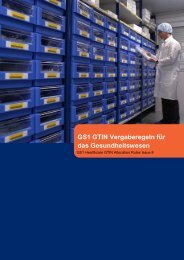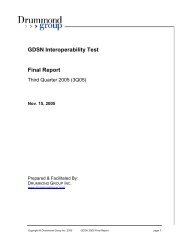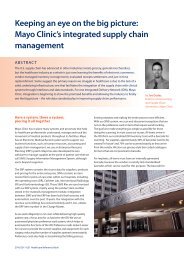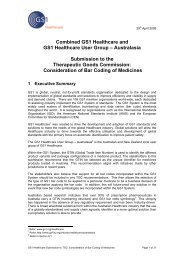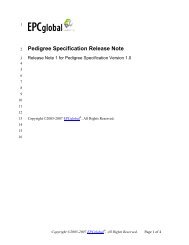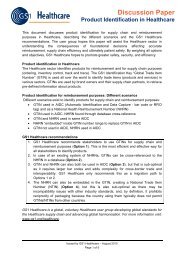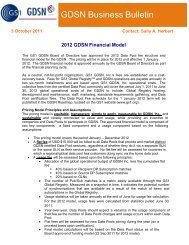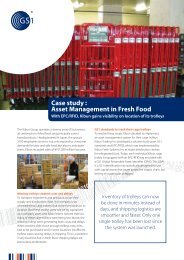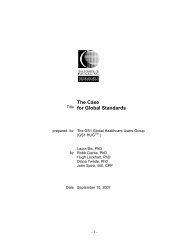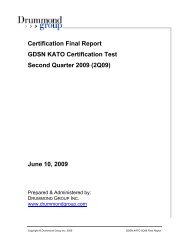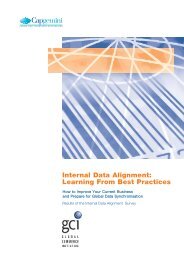GDSN Newsletter No. 5 - GS1
GDSN Newsletter No. 5 - GS1
GDSN Newsletter No. 5 - GS1
Create successful ePaper yourself
Turn your PDF publications into a flip-book with our unique Google optimized e-Paper software.
<strong>GDSN</strong> <strong>Newsletter</strong><br />
N° 5 – June 2009<br />
Also in this issue:<br />
<strong>GDSN</strong> in action................ 1<br />
• Cora supermarkets: synchronising data is<br />
simple, quick and inexpensive<br />
• Auchan France takes the Data Quality<br />
Challenge<br />
• Carrefour, Kraft and P&G synchronising<br />
data in Spain<br />
• <strong>GS1</strong> Germany helps an SME see big<br />
benefits<br />
• Gaining insight with category<br />
management<br />
News from <strong>GDSN</strong>-Certified<br />
data pools .................... 4<br />
• Getting bottom-line results with quality<br />
data: a hardlines case study<br />
• GHX launches the Health Connexion<br />
<strong>GDSN</strong>-certified data pool<br />
• CabasNet having a real impact on<br />
colombian value chains<br />
• NHS supply chain to improve its product<br />
information with <strong>GS1</strong> UK data pool<br />
• Synquinox: new gdsn-certified data pool<br />
• SA2 Worldsync holds successful first<br />
European user congress<br />
• aecocdata at <strong>GS1</strong> Spain: working hard to<br />
help <strong>GDSN</strong> grow<br />
<strong>GDSN</strong> in action<br />
Cora Supermarkets: Synchronising data is simple,<br />
quick and inexpensive<br />
Cora is a chain of supermarkets and hypermarkets within the Louis Delhaize group,<br />
operating in Belgium Hungary, Luxemburg, Romania and the French West Indies.<br />
Cora recently deployed GDS for a variety of reasons: they were seeking a reduction<br />
in administrative and logistical costs, hoping to improve their quality of service,<br />
intending to reduce or eliminate out-of-stocks and speed time-to-market for new<br />
items and promotions. At the heart of their project, though, was a need to replace<br />
the manual treatment of paper documents with a fully automated process.<br />
Cora had some 400,000 active trade items; and by their own estimates, between<br />
25% to 50% of those product files contained errors! By automating their processes<br />
through the <strong>GDSN</strong>, Cora saw the cost of treating a file go down 85%, from 65 Euros<br />
to 10 Euros.<br />
Their project had several steps. In Autumn 2007, Cora engaged the services of a<br />
consultant from LT Solutions, whose task was to identify and deploy a suitable<br />
solution to their problem. In December of that same year, the <strong>GS1</strong> Global Data<br />
Synchronisation Network was chosen as the path to take, and one month later in<br />
January 2008, Cora joined the CDB Data Pool run by <strong>GS1</strong> BelgiLux.<br />
In April 2008, Cora began pilot tests with three different companies: One with<br />
L’Oreal directly through the CDB Data Pool; one with P&G, who use the 1SYNC Data<br />
Status updates<br />
& accomplishments ........... 7<br />
• Healthcare implementation initiative<br />
underway<br />
• Did you know? Segmentation of GTINS<br />
in the <strong>GDSN</strong> today<br />
• Data Quality Challenge phase 1<br />
successfully concluded<br />
• <strong>GDSN</strong> change requests and network<br />
deployments: an update<br />
• Deployment of Maintenance Release 3<br />
(MR3)<br />
• Update on the 2009 –2010 <strong>GDSN</strong><br />
roadmap<br />
• Use <strong>GS1</strong> XML standards internally, too<br />
page 1/8
partners are collaborating through the Data Quality<br />
Challenge to identify key areas within their relationship that<br />
can become improved through the implementation of data<br />
quality principles from the Data Quality Framework.<br />
Bernard Caron CORA & Cristina Monnoyeur L’Oréal Belgique at the 2009<br />
<strong>GS1</strong> Belgium & Luxembourg Forum<br />
Pool in the US but interconnect to the CDB Data Pool; and<br />
one with Andros who use the <strong>GS1</strong> France Data Pool.<br />
Cora found their pilot tests to be quite conclusive. In brief,<br />
they found that exchanging data through the <strong>GDSN</strong> is simple,<br />
quick to put into place, and not costly. They now have a “Yes,<br />
we can!” attitude about global data synchronisation and the<br />
<strong>GDSN</strong>, and are looking to extend their data synchronisation<br />
activities to include other food and consumer goods<br />
companies; to encompass other product categories; and to<br />
benefit other brands within the Louis Delhaize group.<br />
For more information about Cora, visit http://www.cora.be/.<br />
For more information about <strong>GS1</strong> BelgiLux and its CDB<br />
DataPool, visit www.gs1belu.org<br />
Auchan France takes the Data Quality Challenge<br />
<strong>GS1</strong>’s Data Quality Challenge builds upon the <strong>GS1</strong> Data<br />
Quality Framework’s self-assessment procedure. This selfassessment<br />
enables organisations to assess their compliance<br />
by positioning their current status in comparison to best<br />
practices. It also reveals important opportunities that can<br />
be further exploited by trading partners to enhance their<br />
processes for data management and data quality. Trading<br />
Auchan is a group of hypermarkets and supermarkets, most<br />
of which are in Western Europe. Auchan France recently<br />
ran a physical inspection (one of the steps in a data quality<br />
improvement plan). They compared the actual dimensions,<br />
gross weight, GTIN and hierarchy of units, cases and pallets<br />
to what was indicated in files.<br />
Their inspection revealed<br />
errors and even absences in<br />
product information such as<br />
GTIN Logistic Unit level or Gross<br />
Weight, and many instances where product information not<br />
up-to-date between the manufacturer and the retailer. The<br />
results were quite clear: their catalogs were not completely<br />
aligned, and they had work to do.<br />
Auchan France’s key learning was easy to summarise: There is<br />
no data synchronisation without data quality.<br />
In light of the results of their physical inspection, they are<br />
more certain than ever before of the interest and usefulness<br />
of implementing GDS. When manufacturers and retailers are<br />
in alignment, there are fewer discrepancies and a virtuous<br />
circle is created.<br />
Auchan has now created a “Quality Catalog” team, dedicated<br />
to internal Data Quality as well as a Data Quality Steering<br />
Committee. They are widening the scope of Data Quality<br />
by creating specific Working Groups on supply chain. They<br />
have also scheduled a series of targeted trainings for buyers,<br />
catalog teams, and the supply chain.<br />
If your company is just getting started on a data quality initiative,<br />
start by reviewing the ‘Getting Started with Data Quality’<br />
page of our website at http://www.gs1.org/gdsn/dqf/start.<br />
You’ll find guidance on setting up internal data alignment as<br />
a building block towards a more complete comprehensive<br />
data quality management process.<br />
Carrefour, Kraft and P&G synchronising<br />
data in Spain<br />
The key learning: There is<br />
no data synchronisation<br />
without data quality.<br />
Carrefour, Kraft and P&G are three of the many companies<br />
which are synchronising data through aecocdata, <strong>GS1</strong> Spain’s<br />
Data Pool.<br />
Carrefour Spain is driving its deployment very hard. The first<br />
top-to-top meetings were held with suppliers in February<br />
2008, and one year later in March 2009, they had 18 suppliers<br />
live. They truly believe in new ways of doing business with<br />
suppliers, and feel that success lies for partners who manage<br />
categories as if they were one company trying to better serve<br />
common consumers. Carrefour knows that a successful data<br />
<strong>GDSN</strong> <strong>Newsletter</strong><br />
<strong>No</strong>. 5 – June 2009 page 2/8
an item master data project with the METRO Group. Hitschler<br />
International GmbH is a family-run enterprise with a product<br />
base of 300 varieties of sweets and candies. For decades,<br />
Hitschler has had a solid relationship with METRO, one of the<br />
country’s most important retailer groups.<br />
Before the project with <strong>GS1</strong> Germany, Hitschler handled<br />
processes manually: item master data were submitted via fax<br />
or handwritten notes – an inefficient process that inevitably<br />
resulted in a great deal of errors.<br />
synchronisation project is not just an IT project; instead it<br />
must address process changes with end-to-end process<br />
improvement as the goal, and it must be a priority for all<br />
parties involved.<br />
Kraft had already successfully implemented GDS in France in<br />
2007, and found that it offers many advantages – including<br />
quick rollout of new products. Their project in Spain kicked off<br />
in May 2008 with actions including system parameterisation,<br />
business process adaptation, training and testing. They went<br />
live on October 2008, making them one of the 1st food<br />
suppliers in production with Carrefour.<br />
P&G started in Spain with a local solution – an Excel file<br />
uploaded into aecocdata. Since that time, as the company<br />
moved to using global systems like SAP, P&G Spain<br />
interconnected 1SYNC their global Data Pool into aecocdata<br />
and is now publishing data automatically through 1SYNC<br />
globally. Since <strong>No</strong>vember 2007 more than 1,100 products<br />
have been integrated.<br />
All three companies are seeing improvements in service and<br />
reduced costs thanks to their win/win collaborations through<br />
the <strong>GDSN</strong>.<br />
For more information about <strong>GS1</strong> Spain and the aecoc Data<br />
Pool, visit http://www.aecoc.es<br />
<strong>GS1</strong> Germany helps<br />
an SME see big benefits<br />
<strong>GS1</strong> Germany has many initiatives and<br />
programmes underway to help its member<br />
companies; one such programme is Project<br />
PROZEUS, which was launched in July 2002<br />
by the Federal Ministry for Economics and<br />
Labour. The objective of PROZEUS is to help<br />
Small and Medium Enterprises (SMEs) to take<br />
advantage of global markets for purchasing<br />
and sales by means of eBusiness tools.<br />
Hitschler worked with <strong>GS1</strong> Germany to deploy a system to<br />
electronically manage their item master data. They sought<br />
quality management of master and logistic data, internally as<br />
well as on the customer side, so that inaccuracies along the<br />
entire supply chain could be reduced and business processes<br />
could become more efficient.<br />
Before the launch and then during each phase of the project,<br />
<strong>GS1</strong> Germany, together with the master data service provider,<br />
advised Hitschler; including planning the project details,<br />
selecting further service providers and ensuring staff were<br />
trained and qualified.<br />
The project between Hitschler and METRO resulted in a<br />
number of concrete benefits. For example, there were<br />
measurable savings in administrative and processing costs.<br />
Prior to the launch of their project, Hitschler issued an<br />
average of nearly 10 item passports per year per customer,<br />
with an input requirement of a full 4 hours per passport.<br />
Today, using the data pool system now embedded within its<br />
own workflows, Hitschler only devotes 20 minutes to an item<br />
passport. So instead of 100 person-days per year, Hitschler<br />
now needs to spend only 8.4 person-days per year for the<br />
handling of their item passports.<br />
When Hitschler compares the costs of implementing their<br />
project to the savings they have already seen, it turns out that<br />
introducing a master data pool has already paid for itself, in<br />
less than 18 months. Hitschler will of course profit from their<br />
investment in this project even more as the number of their<br />
retail customers supplied with item master data through<br />
the master data pool increases.<br />
And beyond the benefits for Hitschler, the project also<br />
demonstrated how SMEs have the same possibilities<br />
to achieve meaningful advantages by using <strong>GS1</strong><br />
standards as larger companies.<br />
For more information about <strong>GS1</strong><br />
Germany, visit their website at<br />
http://www.gs1-germany.de<br />
For more information about<br />
Project PROZEUS, see http://<br />
www.prozeus.de/<br />
Within the framework of Project PROZEUS, <strong>GS1</strong><br />
Germany recently assisted a smaller supplier to deploy<br />
<strong>GDSN</strong> <strong>Newsletter</strong><br />
<strong>No</strong>. 5 – June 2009 page 3/8
Gaining insight with Category Management<br />
To ensure products are classified correctly and uniformly,<br />
<strong>GDSN</strong> uses <strong>GS1</strong> Global Product Classification (GPC), a system<br />
that gives buyers and sellers a common language for grouping<br />
products in the same way, everywhere in the world.<br />
An updated case study clearly showed the potential values<br />
and benefits of using GPC to enable category management.<br />
The study was focused on the performance of the retailer’s<br />
toys and games department. The various types of toys and<br />
games were all given their GPC category. The performance of<br />
individual GPC bricks, defining categories of similar products,<br />
was measured to ascertain which products are accounting<br />
for the change in performance.<br />
Analysis of the categories of<br />
products sold allowed the retailer<br />
to have significant insights: indeed,<br />
a category overview reveals realistic<br />
business-driven opportunities for<br />
improving sales and greatly increases<br />
shopper understanding as well.<br />
The retailer was able to use the<br />
insight gathered from the category<br />
management study to launch a<br />
development project with concrete<br />
actions and plans built upon<br />
conclusions made in the study,<br />
including actions for store and shelf<br />
re-organizations and promotions.<br />
For more information about GPC and<br />
category management, visit http://<br />
www.gs1.org/gdsn/gpc<br />
1<br />
2<br />
3<br />
GPC CATEGORY<br />
GPC Toys & Games<br />
Class level<br />
Board Games / Cards /<br />
Puzzles<br />
Development /<br />
Educational toys<br />
Dolls / Puppets / Soft<br />
toys<br />
Assessment<br />
Highest % of profit;<br />
<strong>No</strong> in-depth review –<br />
Market is static<br />
COMPARISON<br />
Identification<br />
Criteria<br />
Pocket money toys<br />
Category strategy<br />
Cach Generator<br />
Efficient use of space Education in activity Image Creator<br />
Needs more space;<br />
Range needs to include<br />
best seller<br />
4 Table Games Needs more SKUs<br />
5<br />
Outdoor Games / Play<br />
Structures<br />
6 Role Play Toys<br />
7 Toy Vehicles<br />
12% of profit from 7%<br />
of SKUs<br />
Too many SKUs for the<br />
space<br />
Bulky – but no more<br />
space due to low profit<br />
Attain high market<br />
share; Frequency<br />
purchased high sales<br />
penetration<br />
Good impulse purchase<br />
arsenal<br />
Spread sales thoughout<br />
the year<br />
High Quality / Premium<br />
Gifts<br />
Traffic Builder<br />
Transaction Builder<br />
Cash Generator<br />
Profit Generator<br />
Image Creator<br />
News from <strong>GDSN</strong>-certified data pools<br />
Getting bottom-line results with quality<br />
data: a hardlines case study<br />
In April 2009, <strong>GS1</strong> US published a case study on its recent<br />
collaboration with a leading hardlines retailer in the United<br />
States and several of its suppliers.<br />
The findings of this study confirm the potential for any<br />
company, regardless of size, to realize significant benefits<br />
when accurate data is synchronised. These benefits include<br />
lower freight costs, increased productivity levels, and<br />
improved asset utilization.<br />
Several myths abound in regard to the quality of supply chain<br />
data. These include the false notions that any supply chain<br />
issues caused by slightly inaccurate data must be relatively<br />
insignificant, and that the expenses and resources required<br />
to correct these inaccuracies are not worth the investment.<br />
This way of thinking has caused<br />
companies to ignore data quality<br />
issues for years, but, with this<br />
study, these and other common<br />
myths are disproved.<br />
Prior to exchanging data<br />
through the <strong>GDSN</strong> via 1SYNC,<br />
the retailer had relied on manual<br />
methods of collecting data – a<br />
combination of paper forms<br />
and web-based communications with suppliers, as well<br />
as recording the physical measurements of products in its<br />
distribution centres.<br />
To conduct the study, supply chain standards experts from<br />
<strong>GS1</strong> US visited the retailer’s distribution centres and used<br />
industry-defined <strong>GDSN</strong> Package Measurement Standards<br />
<strong>GDSN</strong> <strong>Newsletter</strong><br />
<strong>No</strong>. 5 – June 2009 page 4/8
to physically measure a sample of 56 warehouse-level cases<br />
and 90 consumer-level items, including products such as<br />
cleaners, gloves, toilet seats, masking tape, nails, screws,<br />
tools, paint, trash units, and electronic timers. The results of<br />
the study revealed that, no matter the size of the participant,<br />
the retailer and its suppliers all had opportunities to improve<br />
their data quality to enable greater supply chain efficiencies.<br />
For example, the retailer and its suppliers had different<br />
weight and dimension data for 80 percent of their cases and<br />
60 percent of their items. These findings are similar to those<br />
previously reported in the Grocery industry.<br />
The complete analysis detailed in this study reveals a clear<br />
message for both retailers and suppliers: improving data<br />
quality at any one point along the supply chain is not<br />
enough. To realize true business benefits, accurate data must<br />
be continuously synchronized between trading partners<br />
throughout the entire product lifecycle. Making these<br />
data quality improvements has the proven potential to<br />
immediately deliver bottom-line benefits for both suppliers<br />
and retailers.<br />
To read the study in its entirety, download “Take a Closer<br />
Look: Getting bottom-line results with quality data” at<br />
http://www.1sync.org/industry_studies.html<br />
GHX launches the Health ConneXion <strong>GDSN</strong>certified<br />
Data Pool<br />
GHX, LLC has launched the GHX Health ConneXion data<br />
pool, a healthcare-focused <strong>GDSN</strong>-certified Data Pool allowing<br />
healthcare organisations to leverage their existing connection<br />
to GHX to more readily participate in the <strong>GDSN</strong> without<br />
significant implementation costs. GHX currently connects<br />
the majority of hospitals in the U.S., as well as hospitals in<br />
Canada and nine European countries, to the suppliers from<br />
whom they purchase a large percentage of their products.<br />
Healthcare suppliers and providers not integrated to GHX<br />
have the option to participate in the Health ConneXion data<br />
pool as a standalone service.<br />
“As part of the <strong>GDSN</strong>, GHX can best help transform<br />
healthcare’s growing appreciation for supply chain standards<br />
into real value by enabling us not only to participate in the<br />
<strong>GDSN</strong>, but also to utilise <strong>GS1</strong> standard product identifiers and<br />
organisation/location identifiers in our business processes, ”<br />
said Mike Brown, director, Materials Management, University<br />
Hospital, Augusta, GA, U.S.A.<br />
Standardisation can make it possible for all trading<br />
partners to utilise the same information from the point<br />
of manufacture to the point of use. “As both a buyer and<br />
a seller of medical products, distributors can benefit in a<br />
variety of ways from participating in Health ConneXion,” says<br />
Gary Haluska, president of DeKroyft-Metz. “We can make<br />
sure we have accurate data on the products we purchase<br />
from manufacturers and in turn can make sure that we are<br />
delivering products to the right place and at the right price.”<br />
For more information about the launch, read the news release.<br />
For more information about GHX, visit www.ghx.com.<br />
CABASnet having a real impact on Colombian<br />
value chains<br />
<strong>GS1</strong> Colombia has seen synchronisation as an important tool<br />
that contributes decisively to increasing efficiency levels in<br />
companies and makes the flow of product and information<br />
simpler.<br />
However, the direct relationship between information<br />
synchronisation and service levels exhibited by companies<br />
is sometimes not so evident. For this reason, <strong>GS1</strong> Colombia<br />
performed a study with eight companies from a variety of<br />
sectors, all of whom have begun information synchronisation<br />
processes through CABASnet.<br />
The study sought to measure the impact of synchronisation<br />
in fundamental variables such as precision of purchase<br />
orders, service level, percent out-of-stock, vendor lost sales<br />
and retailer lost sales.<br />
The study’s results show conclusive figures in terms of a<br />
performance improvement in these key indicators. The<br />
positive impact of information synchronisation through<br />
CABASnet is made visible as soon as one month after<br />
beginning the process and 5-point average improvements<br />
are recorded four months after.<br />
Indicator February March April May<br />
Purchase order precision 83% 85% 89% 91%<br />
Chain service level 75% 76% 83% 83%<br />
Percent out-of-stock 10.6% 9.3% 5.1% 5.9%<br />
Vendor lost sales 4.1% 3.6% 2.1% 2.8%<br />
Chain lost sales 1.1% 1.2% 0.7% 1.0%<br />
Source: <strong>GS1</strong> Colombia Synchronization Impact Study<br />
<strong>GDSN</strong> <strong>Newsletter</strong><br />
<strong>No</strong>. 5 – June 2009 page 5/8
Annete Volcy, HFC System Manager at P&G, confirms the<br />
benefits, especially in simplification. She says her group saw<br />
a reduction of codification time from 1 month to 5 days and<br />
a reduction of de-codification time from more than 1 month<br />
to 3 days. The service level for key accounts using product<br />
suspension increased from 92.7% to 96.7%; additionally,<br />
there was a stabilisation of all the services and processes<br />
of database synchronisation with a key account, with the<br />
service level there increasing from 83% to 95%. Furthermore,<br />
for each increased point in the service level, there was a 0.4%<br />
increases in sales.<br />
For more information about <strong>GS1</strong> Colombia and the CABASnet<br />
Data Pool, visit http://www.gs1co.org/<br />
NHS Supply Chain to improve its product<br />
information with <strong>GS1</strong> UK Data Pool<br />
Using Global Data Synchronisation<br />
(GDS), NHS Supply Chain, the<br />
organisation that manages the<br />
procurement and delivery of more<br />
than 620,000 products for NHS trusts,<br />
hospitals and other healthcare organisations, aims to improve<br />
patient safety and customer service by offering its customers<br />
accurate and additional product information that will help<br />
them save money and reduce errors.<br />
The first phase will be to implement GDS and use the<br />
<strong>GS1</strong> UK Data Pool to exchange product information with<br />
key ready meals suppliers which include major national<br />
and local specialist providers. “Our aim for the initial GDS<br />
implementation is to meet the requirement for a nutritional<br />
database to support the promotion and sales of ready<br />
meals products across the NHS and at the same time<br />
improve patient safety with accurate nutritional and allergy<br />
information,” says Paul White, IT Director at NHS Supply<br />
Chain. “By synchronising accurate and up-to-date product<br />
information with our suppliers we can provide customers<br />
with a high quality catalogue to identify, select and order<br />
products.”<br />
The initial implementation will be completed during 2009<br />
when NHS Supply Chain will widen the scope of their GDS<br />
implementation to more categories which include medical<br />
and surgical products incorporating the orthopaedic range.<br />
For more information about <strong>GS1</strong> UK and the <strong>GS1</strong> UK Data<br />
Pool, visit www.gs1uk.org<br />
Synquinox: New <strong>GDSN</strong>-certified Data Pool<br />
Synquinox has successfully<br />
completed <strong>GDSN</strong> Data Pool<br />
Certification. Synquinox, based<br />
in Las Vegas, Nevada (USA), is a business-focused solutions<br />
provider with a combination of domain expertise in the industry<br />
and the ability to build leading-edge technical solutions that<br />
handle the most complex of problems. Their proven track<br />
record of solving the most important, mission-critical needs<br />
of our customers includes ERP, Business Intelligence, B2B<br />
e-commerce, EDI, and Global Data Synchronization.<br />
The company’s vision is for every Synquinox participant<br />
to experience the benefits of “True Clean Data” to flow<br />
throughout the entire value chain, and to drive cost out of<br />
the supply chain through the implementation of current and<br />
evolving technologies while embracing industry standards<br />
-- ultimately enabling participants to compete in the global<br />
marketplace.<br />
For more information, contact Info@Synquinox.com<br />
SA2 Worldsync holds successful first<br />
European user congress<br />
In May, SA2 Worldsync, a leading <strong>GDSN</strong>-certified data pool<br />
provider, conducted their first European User Congress in<br />
Cologne, Germany. Under the motto “Improving Relationships<br />
with Integrated Solutions,” representatives of customers and<br />
partner companies from 16 European countries gathered to<br />
learn and share information about current developments<br />
and prospects in Data Management, Data Synchronisation,<br />
Product Information Management and EDI.<br />
The congress was an excellent opportunity for all the<br />
delegates to exchange best practice experiences and<br />
opinions. SA2 Worldsync customers including dennree, SCA<br />
and Mars gave clear presentations of best practices based<br />
on their deployment projects and experience. The METRO<br />
Group explained how it is opening up new markets with SA2<br />
Worldsync as part of their global GDS rollout. The congress<br />
also covered current projects and themes from the Franchise<br />
and Joint Venture partners in regions such as Belgium,<br />
Denmark, Finland, Italy, Russia or Poland.<br />
Further information on SA2 Worldsync is available at<br />
www.sa2worldsync.com<br />
aecocdata at <strong>GS1</strong> Spain: Working hard to help<br />
<strong>GDSN</strong> grow<br />
This year, <strong>GS1</strong> Spain has one of the highest figures for growth on<br />
<strong>GDSN</strong> implementation within <strong>GS1</strong>. One of their main initiatives<br />
was the meeting held in March 2009 between two of the most<br />
important retailers in Spain and a group of their main shared<br />
suppliers. “For us,” said a participant from Carrefour, which uses<br />
the aecocdata Data Pool, “<strong>GDSN</strong> is a necessity and is one of the<br />
priorities of the Carrefour Group strategy.”<br />
“The objective of El Corte Ingles,” said a representative from<br />
that retailer, which uses SA2 Worldsync to exchange their<br />
data, “is that all our providers are ready or working in a <strong>GDSN</strong><br />
solution in 2009.”<br />
<strong>GDSN</strong> <strong>Newsletter</strong><br />
<strong>No</strong>. 5 – June 2009 page 6/8
That same month, <strong>GS1</strong> Spain created the <strong>GDSN</strong> Working<br />
Group, composed of Agua mineral San Benedetto, Carrefour,<br />
Coca-Cola, Consum, Danone, El Corte Ingles, Eroski, Henkel,<br />
Kraft, Pescanova, Procter & Gamble, Unilever Foods and <strong>GS1</strong><br />
Spain. These members agreed that the mission of this group<br />
would be to:<br />
• Validate operational running of <strong>GDSN</strong> in Spain.<br />
• Define and agree Spanish needs on Data Synchronisation.<br />
• Define and agree best practices on <strong>GDSN</strong> standards<br />
implementation.<br />
As complement to these activities, during the first quarter of<br />
this year, aecocdata implemented Promotional Trade Item<br />
Extension. This action responds to users’ requests and will<br />
certainly help extend and increase the use of <strong>GDSN</strong> in the<br />
Spanish market.<br />
For more information about <strong>GS1</strong> Spain and the aecocdata<br />
Data Pool, visit http://www.gs1es.org/<br />
Updates & News<br />
Healthcare implementation initiative underway<br />
<strong>GS1</strong> Healthcare has launched a user-led initiative to take<br />
significant steps towards the global use of <strong>GDSN</strong> for<br />
healthcare products. This implementation initiative aims to<br />
demonstrate that the <strong>GDSN</strong> is uniquely positioned to meet<br />
current and emerging requirements for electronic product<br />
catalogue data, including pending regulatory demands<br />
and commercial needs for reliable product data between<br />
healthcare trading partners.<br />
In Phase 1, due to end in June, participants are loading<br />
healthcare products in the <strong>GDSN</strong> in order to create a shared,<br />
global set of master product data attributes for healthcare<br />
and a single global source for this data in healthcare. They<br />
also hope to identify gaps to help the industry understand<br />
the opportunities and barriers for broader implementation.<br />
A more complete description of can be found here.<br />
Did you know? Segmentation of<br />
GTINs in the <strong>GDSN</strong> today<br />
The <strong>GDSN</strong> today is home to more than 3,700,000 GTINs, 2.6<br />
million of which are registered with a GPC code as well. While<br />
“Food, Beverage and Tobacco” and “Beauty, Personal Care and<br />
Hygeine” are by the two most popular industry segments,<br />
representing 46% of all GTINs, other segments in the top-10<br />
show the increasing uptake of global data synchronisation in<br />
other industries, such as DIY/hardlines and healthcare.<br />
Data Quality Challenge Phase 1<br />
successfully concluded<br />
In April 2008, 16 leading retailers and suppliers, of which 12<br />
“Etoile participants”, have answered the call to participate<br />
in the Data Quality Challenge, a user-driven programme to<br />
boost data quality and support the Data Quality Framework.<br />
All participants have now evaluated the available tools of<br />
the Data Quality Framework, tested the self-assessment<br />
procedure, and assessed business process improvements.<br />
The Data Quality Steering Committee is currently analysing<br />
all the feedback that has been collected and will, based on the<br />
results, make a recommendation for the next steps and define<br />
the strategy for “Phase II” of the Data Quality Challenge.<br />
<strong>GDSN</strong> change requests and<br />
network deployments: An update<br />
<strong>GDSN</strong>, Inc. (in conjunction with key stakeholders) follows a<br />
straightforward process that encompasses the <strong>GS1</strong> Global<br />
Standards Management Process (GSMP) for the submission<br />
and deployment of requests for changes and enhancements<br />
to the network. The overall process is straightforward:<br />
There is one way to submit a request. All requests are<br />
entered as a Change Request (CR) and reviewed by the<br />
GSMP. Depending on the work effort required, <strong>GDSN</strong> Board<br />
approval may be required prior to proceeding. Simple CRs<br />
are processed through the established <strong>GDSN</strong> Business<br />
Requirements Group (BRG). Complex CRs require the<br />
formation of a GSMP Workgroup for that specific CR, for<br />
which <strong>GDSN</strong> Board approval is required.<br />
There are two ways to deploy into the network, both of<br />
which require <strong>GDSN</strong> Board approval. <strong>GDSN</strong> also engages the<br />
<strong>GDSN</strong> Architecture team and <strong>GDSN</strong> Certification Agent, if<br />
applicable, in Implementation and Release planning.<br />
• The first way to deploy into the network is via a Maintenance<br />
Release, which are composed primarily of Simple and<br />
Complex CRs with no impacts to backwards compatibility<br />
of the network.<br />
• The second way is via Certification Events, which are<br />
composed of Complex CRs that have a major impact to<br />
end user implementation and are usually non backwards<br />
compatible to the existing version in the network.<br />
<strong>GDSN</strong> <strong>Newsletter</strong><br />
<strong>No</strong>. 5 – June 2009 page 7/8
To date, the majority of network requirements have been<br />
accomplished successfully through simple CRs. Of the<br />
Complex CRs approved by the Board, the majority of<br />
those have been successful in being deployed through<br />
the maintenance release process, leaving only a few<br />
significant and strategic CRs requiring certification prior to<br />
implementation.<br />
For more detailed information about the <strong>GDSN</strong> delivery<br />
process, the GSMP standards development process, and<br />
the roles and responsibilities of all parties involved, please<br />
download this overview.<br />
Deployment of Maintenance Release 3 (MR3)<br />
On 28 March 2009, Maintenance Release 3 (MR3) was deployed<br />
into production into the <strong>GDSN</strong>. MR3 contains changes to<br />
the Trade Item and Price Synchronisation messages and<br />
addressed over 30 change requests.<br />
For more information, view the bulletin.<br />
Update on the 2009 –2010 <strong>GDSN</strong> roadmap<br />
At their June 11, 2009 meeting, the <strong>GDSN</strong> Board approved a<br />
number of roadmap projects:<br />
• Price Looping, to provide the ability to send multiple price<br />
values on a single price record;<br />
• Preliminary Trade Item Information, to enable users to<br />
indicate that the Trade Item information for a new item that<br />
is passed to the data recipient is preliminary and will be<br />
updated to its final values at a later stage:<br />
• Target Market subdivision, to address the issue when<br />
Target Market Subdivision Code is populated in one or both<br />
of the Catalog Item Subscription (CIS) and Catalog Item<br />
Publication (CIP) messages;<br />
• Ti/Hi: to enable the use and application of the TI/HI attributes<br />
[TI/HI: the number of boxes/cartons stored on a layer (the TI)<br />
and the number of layers high that these will be stacked on<br />
the pallet (the HI)].<br />
<strong>GDSN</strong>, Inc. proposed these projects based on the outcome of<br />
a <strong>GDSN</strong> user group survey, part of the due diligence process<br />
performed by <strong>GDSN</strong>, Inc. Each project here was evaluated on<br />
14 different criteria. The final selection rationale<br />
was made after asking ourselves: Does it<br />
support mass growth and adoption? Are<br />
there users ready to start working on<br />
the project? Is there an “in network”<br />
alternative solution? Are there<br />
significant Global Registry /<br />
budget implications?<br />
Position papers already<br />
exist for several key<br />
<strong>GDSN</strong> roadmap projects<br />
to come:<br />
• Position paper on Statement Modular Item<br />
• Position paper on <strong>GDSN</strong> for Chemical Ingredients<br />
• Position paper on Party Synchronisation [if available]<br />
Use <strong>GS1</strong> XML standards internally, too<br />
While the use of <strong>GS1</strong> XML Standards is required for electronic<br />
data interchange within the <strong>GDSN</strong>, other proprietary<br />
messaging solutions are sometimes used outside the <strong>GDSN</strong><br />
to exchange the same data internally at the trading partner, or<br />
between trading partners and data pools. <strong>GDSN</strong> Inc. however<br />
recommends the use of the <strong>GS1</strong> XML standards also in those<br />
cases as well, and encourages <strong>GDSN</strong>-certified data pools to<br />
offer these services to their trading partner communities.<br />
The Trade Item model that drives the <strong>GDSN</strong> has been<br />
successfully used by many companies as a means for<br />
internal communication between disparate manufacturing<br />
locations, or with newly<br />
acquired divisions. This<br />
internal use of the <strong>GS1</strong><br />
global standard enables<br />
efficient communication<br />
within companies as well as<br />
between them.<br />
The <strong>GS1</strong> System is an<br />
integrated system of global<br />
standards: leveraging<br />
existing standards is consistent with the published<br />
<strong>GS1</strong> Architectural Principles and will reduce the cost of<br />
implementation as well as optimise the supply chain.<br />
“<strong>GDSN</strong>-certified data pools should offer services to their<br />
customers to send and receive data using <strong>GS1</strong> standards”,<br />
says Staffan Olsson, Head of Standards & Implementation,<br />
<strong>GS1</strong> Sweden. “Proprietary solutions will increase cost for<br />
everyone: ERP system providers will have to build different<br />
solutions for different data pools.”<br />
For more information about <strong>GS1</strong> XML standards, visit<br />
http://www.gs1.org/ecom/xml/overview<br />
The <strong>GDSN</strong> <strong>Newsletter</strong> is a publication of:<br />
<strong>GS1</strong> <strong>GDSN</strong><br />
Blue Tower, Avenue Louise 326, b10<br />
BE 1050 Brussels, Belgium<br />
T +32 (0)2 788 7800<br />
F +32 (0)2 788 7899<br />
Publisher: Sally Herbert, sally.herbert@gs1gdsn.org<br />
Editors: Jan Denecker, jan.denecker@gs1.org<br />
Visit: www.gs1.org/gdsn<br />
<strong>GDSN</strong> Inc. recommends<br />
the use of the <strong>GS1</strong> XML<br />
standards to exchange<br />
data within a company,<br />
and between trading<br />
partners and data pools.<br />
page 8/8


